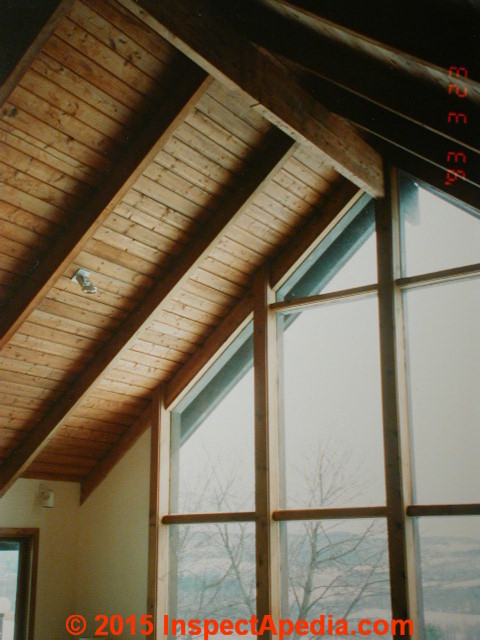

AND, because you have a 1x ridge board (not a ridge beam), putting purlins/king posts here and there down from the ridge board to the middle wall doesn't accomplish much, especially if there is no foundation under that middle wall. AND raising those ceiling joists reduces the carrying capacity of the rafters to 0.76x(span), so if your 2圆 rafters were rated to span 11'-9", they are now reduced to 8'-11" in its capacity to carry the roof load. BUT, you raised the ceiling joists 18" of the total 6' distance to the top of ridge from the top plate, so you need to increase the amount of nails to 1.33x(6) = (8) nails. spacing - you would need (6) 16d nails to hold against outward thrust (same on the ceiling joist lap splice). Say you have a 4:12 roof pitch, 30psf snow load, 20ft span with the 16"o.c. I think I see (3) nails on the ceiling joist/rafter connection, that is probably not enough. The distance you raise the ceiling joists affects the ability of the existing rafters to carry your roof load and the strength of connections at both the ceiling joist/rafter and the ceiling joist lap splice (in your case straps). There should be a strap across every ceiling joist tying both sides together. Here is a good explanation of the function of rafter ties vs. Adding joist hangers will help some, but only if you use screws instead of nails to attach them to the wall.Ī more effective solution would be to add metal tension strips across the top and bottom of each ceiling joist pair to "join" each ceiling joist to the opposing ceiling joist. Unfortunately, your ceiling joists have a butt joint, and butt joints are terrible at resisting tension. they need to have a "lap" joint where the nails are in shear to resist the tension loads. Your rafter ties (or ceiling joists) need to be continuous across the whole house. They serve as tension members to prevent spreading of the outer walls due to snow load. Rafter ties, by definition, need to be located in the lower 1/3 of the rafter. Your ceiling joists need to act as functional "rafter ties" when no structural ridge beam exists, as is the case here. Your roof framing lacks proper rafter ties. Depending on your project's design, the cables can span between the bottoms of rafters, like ceiling joists, or near the roof's peak, like collar beams.Percyj, this framing definitely appears improper to me. The cables typically connect to framing materials via specialized hooks, brackets or turnbuckles. Steel cables are often substituted for lumber collar ties. The plate braces the rafter against thrusting force and serves as a central nailing surface, a sort of ridge board, for additional framing members. In a flitch plate rafter, an upside-down, V-shaped plate is sandwiched between two sets of rafters. Builders occasionally apply flitch plates to rafters. Flitch Plate Beamsįlitch plate beams consist of steel plates laminated between lumber beams. Custom brackets and braces are particularly useful as tie beam substitutes in complex roof structures, such as large hip and valley roofs with cathedral ceilings. Custom connectors typically mount to the tops of load-bearing walls, across the wall's center or at corners. Don't look for these types of construction connectors at the local hardware store they're usually project-specific, with specifications designed by the engineer or architect. You should consult an architect or engineer to determine if this option is suitable for your project.Įngineers and architects occasionally substitute wall-mounted plates, brackets or braces for tie beams.
COLLAR TIES VS RAFTER TIES FULL
In many cases, the beam bears the full load of the roof, allowing you to run rafters from the beam to surrounding walls without bracing or crossbeams. Structural Ridge BeamsĬonstructing the roof's ridge with a structural beam, such as an engineered beam or solid timber, sometimes eliminates the need for collar ties or tie beams. Similarly, gusset plates interfere with an open-ceiling design. Like collar beams, gusset plates join opposite rafters and brace them against the thrust. Therefore, gusset plates are often triangular or trapezoidal. The term gusset plate refers to a sheet material, such as plywood or metal, that attaches to the face of adjacent rafters, usually near the roof's peak. Gusset plates offer an alternative to tie beams in roofing. This inherent feature practically ensures that flat and shed roof structures have open-ceiling interiors. In flat and shed roof designs, solid planks or beams called joists run between opposite walls and often form the installation surface for both the ceiling covering and roof covering materials. Flat roofs and shed roofs are the most notable examples. In flat or shed roof structures, open-ceiling designs don't require tie beams.Ĭertain roof designs don't require tie beams.


 0 kommentar(er)
0 kommentar(er)
